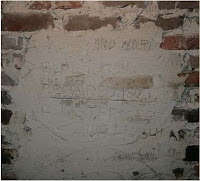I would like to start with some history on the house. The land was granted in 1708 to French Settlers but did not prove to be productive agriculturally by the first three owners. The first crops of Louisiana were Indigo. It was noxious to process and attracted many insects. Slaves processing Indigo only lived five years on average. Sugarcane was difficult to ship until the process of cooking the cane into sugar crystals was discovered. It did not become a major crop of the area until after the plantation was sold to Santiago Llorens in 1771.
Llorens used the property for a cattle ranch and to grow food. He is believed to be the man who built the Spanish Custom House. The house is said to be built in 1784 according to some marks left on the chimney in the attic and a description of the house was in his succession. This was the year Llorens died but it is very possible that the house was built as early as the mid 1700's. Unfortunately, records on the Spanish Custom House were not kept or were burnt in the French Quarter fires of 1788 and 1794. We know Llorens was an important man of the times since he was buried inside St. Louis Cathedral. The practice of burying notable members of the community in the cathedral was halted when it was deemed a health risk in the early 1800's. He, also, owned a home in the French Quarter as would a person of wealth would have during this period. In addition, he bought the land which became City Park in the 1770's. When he died in 1784 he willed the land to his son-in-law and daughter. The land became Allard Plantation. In 1807 the Spanish Custom House was sold to Captain Elie Beauregard by Allard on behalf of the son of Llorens. Captain Elie Beauregard was the father of the famous General P.G.T. Beauregard. In 1809 Louis Blanc and Louis Fortin purchased the property to develope the Faubourg Pontchartrain neighborhood including Fortin St., Mystery St. and Ponce de Leon. They, also, sold smaller tracks of land where Holy Rosary is today and Luling Mansion. It is believed that Louis Blanc lived in the Spanish Custom House in 1809. Blanc was the land surveyor who planned and laid out the French Quarter. Also, the Spanish government placed him in charge of collecting fees for using Bayou St. John. It is believed that is how the house got it's name even though it was never officially a customs house. In 1813 Blanc ceded his rights to the house to Louis Fortin. This is when Fortin moved into the home. The next major owner of the house was Pierre Roux in 1816. He was a grocer and a creole. Roux was the finest furniture maker of the 1700's. He became friends with Louis Fortin when Fortin hired him to make an armoire for a wedding gift to his wife. Roux moved to New Orleans to go into business with Fortin. He stopped making furniture once he moved to New Orleans. The first auction of the house was to Roux's children after his death. Roux's son married Fortin's daughter and they were the next owners of the house. The house remained in the Roux family until 1901.
Helen Pitkin Schertz purchased the home in 1909. She was an author, musician, feminist, preservationist and socialite. Mrs. Schertz was very active in the woman suffrage movement. It was in the Spanish Custom House where the New Orleans Spring Fiesta was founded. She is credited with a major renovation of the home including the rear addition of the music room in 1927. After her death she left the house to her African American housekeeper. Out of respect to Mrs. Schertz she would not sell the home. Unfortunately, the house remained unoccupied for several years and was in bad condition. Upon her death the house was auctioned for the second time and purchased by Dr. and Mrs. Ignatius M. DeMatteo in 1945.
Dr. DeMatteo was the next in line to restore and renovate the house. In addition, he added the reproduction of the kitchen house and brick oven. The house was auction in 2009 by his children after his death in 2001. The house was for sale for several years but between the economy and Hurricane Katrina the children were unable to find a buyer. It was at the auction in February 2009 that I purchased the house and started this exciting journey. The DeMatteo Children still remain in touch with me and are very interested in the renovation of the home. It is a part of their heritage and I am pleased to share this adventure with them and everyone who chooses to follow this blog.
 I think it is now appropriate to share some folklore about the house. No one knows how the house got its name, "Spanish Custom House". There are no records that the house served a customs house but Louis Blanc collected fees for the Spanish Government when he lived in the house. The house boarders Grand Route St. John and Moss Street.
I think it is now appropriate to share some folklore about the house. No one knows how the house got its name, "Spanish Custom House". There are no records that the house served a customs house but Louis Blanc collected fees for the Spanish Government when he lived in the house. The house boarders Grand Route St. John and Moss Street. Grand Route St. John is the oldest street in the city and is believed to be an old Native American trail from Bayou St. John to the French Quarter. It is said that the Native Americans showed Bienville and Iberville the path from the Mississippi River to Bayou St. John. The Natives explained that it was too hard to navigate the Mississippi River. The mouth was always changing and in conjuction with the currents, changing sand bars, it would take over a month to sail a ship up the river. Instead the Native Americans showed Bienville and Iberville a way to sail ships into Lake Pontchartrain to the mouth of Bayou St. John. This is how it was decided where New Orleans would be settled. Once the ships docked at the mouth of Bayou St. John goods would be transferred to smaller boats which would sail up the bayou to the trail next to the house. The goods were then off loaded to be delivered to the French Quarter. If you click on the map you can see the route to Bayou St. John from Rue du Maine. It makes sense that the house would serve as an office to collect fees for using the bayou for commerce. It is, also, thought that the house jailed pirates and smugglers that used the bayou for illegal gain. The back galleries were altered very early adding two rooms (Cabinettes) on each floor. It is believed one room on the bottom floor was used as a holding cell until prisoners were transferred to the jail in the French Quarter. The other room downstairs was used to store the confiscated goods.
It is documented that General Andrew Jackson stayed at the house and met the Privateer Jean Lafitte and Governor Claiborn. The house was chosen because it was outside the French Quarter and considered to be in the country. They did not want General Jackson to be seen with a known criminal. After their meeting General Jackson accepted Jean Lafitte's help and pardoned him.
To think of the history of the house is mind boggling. The land was deeded by the French government nearly seventy years before our country was formed and ten years before New Orleans was founded. It changed hands to the Spanish, back to the French and then sold to the USA in New Orleans. It survived the Civil War, Slavery, changes in government, plagues, fires, insects and many hurricanes. It is very likely that many famous dignitaries would have visited the house. What a wonderful heritage for our city and hopefully it will survive many centuries to come.







No comments:
Post a Comment
Note: Only a member of this blog may post a comment.